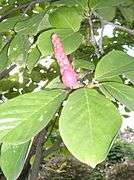Magnolia denudata
| Yulan magnolia | |
|---|---|
| Scientific classification | |
| Kingdom: | Plantae |
| (unranked): | Angiosperms |
| (unranked): | Magnoliids |
| Order: | Magnoliales |
| Family: | Magnoliaceae |
| Genus: | Magnolia |
| Subgenus: | M. subg. Yulania |
| Section: | M. sect. Yulania subsect. Yulania |
| Species: | M. denudata |
| Binomial name | |
| Magnolia denudata | |
| Synonyms[1] | |
| |
Magnolia denudata, known as the lilytree[2] or Yulan magnolia (simplified Chinese: 玉兰花; traditional Chinese: 玉蘭花; pinyin: yùlánhuā; literally: "jade orchid/lily"), is native to central and eastern China.[3] It has been cultivated in Chinese Buddhist temple gardens since 600 AD. Its flowers were regarded as a symbol of purity in the Tang Dynasty and it was planted in the grounds of the Emperor's palace. It is the official city flower of Shanghai.
Description
Magnolia denudata is a rather low, rounded, thickly branched, and coarse-textured tree to 30 feet (9.1 m) tall. The leaves are ovate, bright green, 15 cm long and 8 cm wide. The bark is a coarse, dark gray. The 10–16 cm white flowers that emerge from early to late spring, while beautiful and thick with a citrus-lemon fragrance, are prone to browning if subjected to frost.
Cultivation
Magnolia denudata is used as an ornamental tree in gardens. It is similar to other magnolias in that it likes rich, moist soil and should be planted in a location where it is protected from elemental extremes. This plant has gained the Royal Horticultural Society's Award of Garden Merit.[4]
References
- ↑ The Plant List: A Working List of All Plant Species, retrieved 29 May 2016
- ↑ "Magnolia denudata". Natural Resources Conservation Service PLANTS Database. USDA. Retrieved 28 June 2015.
- ↑ Nianhe Xia, Yuhu Liu & Hans P. Nooteboom. "Yulania denudata". Flora of China. Missouri Botanical Garden, St. Louis, MO & Harvard University Herbaria, Cambridge, Massachusetts. Retrieved 2 May 2013.
- ↑ "Magnolia denudata". Royal Horticultural Society. 2017. Retrieved 2017-01-24.
External links
| Wikimedia Commons has media related to Magnolia denudata. |
| Wikispecies has information related to Magnolia denudata |

